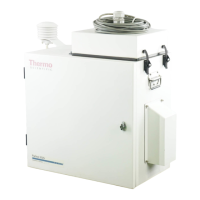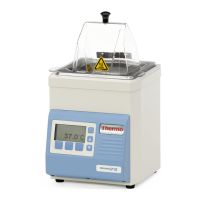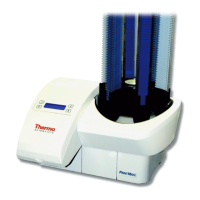Do you have a question about the Thermo Scientific Phadia 100 and is the answer not in the manual?
Provides an overview of the instrument's main components and their locations.
Lists the detailed technical specifications of the instrument, including dimensions, power, and fuses.
Specifies operating environment parameters and interface connection types.
Outlines the electrical safety standards and compliance directives.
Lists safety warnings and operational constraints for instrument use.
Provides step-by-step instructions for installing the instrument.
Details setting up instrument parameters like date, time, language, and communication.
Explains how to navigate the instrument's menu system and enter data.
Describes functions like selecting alternatives and handling messages.
Explains how to view status and understand error messages.
Details the functions of the instrument's panel keys and indicators.
Outlines procedures for evaluating and printing assay data.
Covers setting up and configuring assay methods.
General guidelines for handling reagents, samples, and instrument care.
Detailed handling for specific reagent types like ImmunoCAP and EliA.
Information on dead volumes in tubes and required specifications.
Explains instrument dilutions and acceptable sample tube types.
Instructions for editing requests, sample IDs, and test names.
How to change replicate or dilution factors for tests.
Procedures for selecting and adding quality controls manually.
Instructions for skipping ImmunoCAP/EliA Well loading.
Steps for aborting prepared or running assay processes.
Procedures for printing patient and laboratory reports.
Instructions for exporting assay data to external media and importing it.
Printing and editing quality control and curve control logs.
Managing calibrators, including setting active status and acceptance.
Procedures for exporting quality control and calibrator logs.
Understanding the principles and general flow of monthly calibration.
Rules and conditions for accepting calibration curves.
Overview of quality assurance requirements and implementation.
Criteria for control samples and quality control of specific assays.
Information on Quality Club and monthly reports for performance comparison.
Understanding expected assay results and costs associated with quality.
Accessing and navigating the method setup menu.
Step-by-step process for adding new assay methods.
Modifying general parameters, reagents, and report settings for methods.
Creating and managing test panels for assay run setups.
Adding, editing, and deleting articles (e.g., allergens) in the system.
Generating an instrument event log for troubleshooting.
Overview of all reports and lists printable from the instrument.
Instructions for printing request and consumption lists.
Procedures for printing detailed laboratory and patient reports.
How to print calibrator data and quality control logs.
Importance of regular maintenance and time intervals.
Steps for daily rinse and cleaning of instrument components.
Guidelines for performing weekly cleaning tasks.
Detailed steps for monthly cleaning, lubrication, and carousel care.
Replacing wash/rinse tubings and drainage filters.
Procedures for selftests, blank runs, paper loading, and fuse replacement.
Form for recording performed maintenance actions.
Overview of error types, messages, and initial troubleshooting.
Identification and resolution of errors during preparation and processing.
Troubleshooting common errors affecting assay results.
Guidance on resolving issues related to power, communication, and printouts.
Detailed corrective actions for various error codes and messages.
Documenting the cleaning process before instrument shipment.
Step-by-step guide for safely repacking the instrument for transport.
List of available accessories, spare parts, and supplement products.
Provides an overview of the instrument's main components and their locations.
Lists the detailed technical specifications of the instrument, including dimensions, power, and fuses.
Specifies operating environment parameters and interface connection types.
Outlines the electrical safety standards and compliance directives.
Lists safety warnings and operational constraints for instrument use.
Provides step-by-step instructions for installing the instrument.
Details setting up instrument parameters like date, time, language, and communication.
Explains how to navigate the instrument's menu system and enter data.
Describes functions like selecting alternatives and handling messages.
Explains how to view status and understand error messages.
Details the functions of the instrument's panel keys and indicators.
Outlines procedures for evaluating and printing assay data.
Covers setting up and configuring assay methods.
General guidelines for handling reagents, samples, and instrument care.
Detailed handling for specific reagent types like ImmunoCAP and EliA.
Information on dead volumes in tubes and required specifications.
Explains instrument dilutions and acceptable sample tube types.
Instructions for editing requests, sample IDs, and test names.
How to change replicate or dilution factors for tests.
Procedures for selecting and adding quality controls manually.
Instructions for skipping ImmunoCAP/EliA Well loading.
Steps for aborting prepared or running assay processes.
Procedures for printing patient and laboratory reports.
Instructions for exporting assay data to external media and importing it.
Printing and editing quality control and curve control logs.
Managing calibrators, including setting active status and acceptance.
Procedures for exporting quality control and calibrator logs.
Understanding the principles and general flow of monthly calibration.
Rules and conditions for accepting calibration curves.
Overview of quality assurance requirements and implementation.
Criteria for control samples and quality control of specific assays.
Information on Quality Club and monthly reports for performance comparison.
Understanding expected assay results and costs associated with quality.
Accessing and navigating the method setup menu.
Step-by-step process for adding new assay methods.
Modifying general parameters, reagents, and report settings for methods.
Creating and managing test panels for assay run setups.
Adding, editing, and deleting articles (e.g., allergens) in the system.
Generating an instrument event log for troubleshooting.
Overview of all reports and lists printable from the instrument.
Instructions for printing request and consumption lists.
Procedures for printing detailed laboratory and patient reports.
How to print calibrator data and quality control logs.
Importance of regular maintenance and time intervals.
Steps for daily rinse and cleaning of instrument components.
Guidelines for performing weekly cleaning tasks.
Detailed steps for monthly cleaning, lubrication, and carousel care.
Replacing wash/rinse tubings and drainage filters.
Procedures for selftests, blank runs, paper loading, and fuse replacement.
Form for recording performed maintenance actions.
Overview of error types, messages, and initial troubleshooting.
Identification and resolution of errors during preparation and processing.
Troubleshooting common errors affecting assay results.
Guidance on resolving issues related to power, communication, and printouts.
Detailed corrective actions for various error codes and messages.
Documenting the cleaning process before instrument shipment.
Step-by-step guide for safely repacking the instrument for transport.
List of available accessories, spare parts, and supplement products.
| Brand | Thermo Scientific |
|---|---|
| Model | Phadia 100 |
| Category | Laboratory Equipment |
| Language | English |











